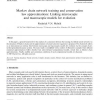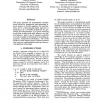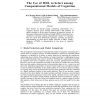BMCBI
2010
14 years 5 months ago
2010
Background: The study of biological systems demands computational support. If targeting a biological problem, the reuse of existing computational models can save time and effort. ...
AMC
2008
14 years 5 months ago
2008
In this paper, a general framework for the analysis of a connection between the training of artificial neural networks via the dynamics of Markov chains and the approximation of c...
ISMB
1993
14 years 6 months ago
1993
Understanding self-replication from an information processing perspective is important because, amongother things, it can shed light on molecular mechanismsof biological reproduct...
ACL
1994
14 years 6 months ago
1994
This paper presents our implemented computational model for interpreting and generating indirect answers to Yes-No questions. Its main features are 1) a discourse-plan-based appro...
NIPS
2000
14 years 6 months ago
2000
How should we decide among competing explanations of a cognitive process given limited observations? The problem of model selection is at the heart of progress in cognitive scienc...
NIPS
2007
14 years 6 months ago
2007
Current computational models of bottom-up and top-down components of attention are predictive of eye movements across a range of stimuli and of simple, fixed visual tasks (such a...
BVAI
2007
Springer
14 years 9 months ago
2007
Springer
Abstract. The aim of this paper is to introduce a novel, biologically inspired approach to extract visual features relevant for controlling and understanding reachto-grasp actions....
WAPCV
2004
Springer
14 years 10 months ago
2004
Springer
A number of computational models of visual attention exist, but making comparisons is difficult due to the incompatible implementations and levels at which the simulations are con...
NMR
2004
Springer
14 years 10 months ago
2004
Springer
This paper presents a computational model for reasoning with causal explanations of observations within the framework of Abductive Event Calculus (AEC). The model is based on abdu...
CIE
2005
Springer
14 years 11 months ago
2005
Springer
We argue that there is currently no satisfactory general framework for comparing the extensional computational power of arbitrary computational models operating over arbitrary doma...







